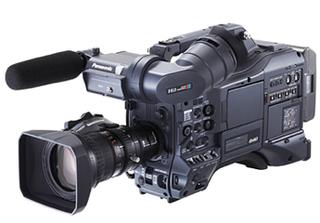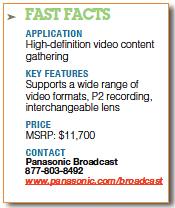Panasonic HPX370 P2 HD Camcorder

The Panasonic HP X370 P2 HD Camcorder
The Panasonic HPX370 breaks new ground in the HD camcorder landscape by offering a fully professional, shoulder-mounted HD camera at an unprecedented price point. This camera is ideal for news, documentary and even digital cinema production, as it accepts interchangeable lenses and records onto P2 cards in virtually all frame rates and formats.
FEATURES
The Panasonic HPX370 incorporates a new line of chips and processing technology to achieve greater sensitivity in low light, as well as outstanding image detail, color depth and low noise. It employs three 2.2 megapixel chips based on "Ultra Luminance Technology" which attain a light sensitivity that surpasses many cameras with larger sensors. Although the HPX370 has 1/3-inch imager sensors, it offers 10-bit, 4:2:2, full 1920x1080 resolution.
Another important feature of the HPX370 is that it uses intra-frame compression in all codecs (AVC-Intra and DVCPRO HD), as opposed to Long GOP. By confining the compression to individual frames instead of spreading it out over a group of frames, it is more NLE friendly. AVC-Intra is a new and very efficient, 10-bit codec. With Master-quality AVC-Intra 100, the HPX370 attains a nearly lossless image quality. And AVC-Intra 50 is useful when you need to conserve bandwidth, as it produces an image quality similar to DVCPRO HD at half the bit-rate.
The HPX370 has two P2 card slots, which provide plenty of recording capacity now that P2 cards have reached 64 GB capacity. Two 64 GB cards provide more than two hours of recording time at the maximum bit rate (AVC-Intra or DVCPRO HD at 100 Mbps), or 256 minutes when using AVC-Intra at 50 Mbps.
The HPX370 records in just about every format and frame rate in use. These include 1080 @ 60i, 50i, 30p, 25p, 24p and 24pN; 720 @ 60p, 50p, 30p, 25p, 24p, and 24pN; and SD 480 @ 60i, 30p, 24p and 24pA.
In addition, you can use the new AVC-Intra codec or the DVCPRO HD codec, which may facilitate integration with existing equipment or facilities. SD can be recorded in DVCPRO 50 or DVCPRO DV.
The HPX370 ships with a detachable Fujinon 17x zoom lens on a 1/3-inch bayonet mount. At its widest setting, the lens is rated as f-1.6, making it quite light sensitive.
In the 720 24p or 30p modes, the HPX370 can record genuine slow and fast motion by varying the frame rate, which is is adjustable from 12 fps to 60 fps.
A seemingly minor feature, but one that vastly improves the image in outdoor photography is Dynamic Range Stretch. This, along with a 20-bit digital signal processor, gives this camera an impressive ability to handle high contrast lighting. In addition, the HPX370 has seven Scene File settings to tailor the image to a preferred look. These include two Cine settings that emulate the color and contrast curve of film.
The HPX370 has a high-resolution LCD screen and a color viewfinder, which can operate simultaneously. The camera also has a built-in waveform monitor and vectorscope which can be displayed on command.
The power consumption has been reduced to about half that of its precursors due to an innovative DSP board and MOS image sensors.
For interface connections, the HPX370 has just about everything, including HD/SD SDI out, composite video out with automatic down-conversion, IEEE 1394, USB2.0, timecode in/out, and genlock.
Another significant feature is P2 card recording, which is now quite affordable and handles high data rates with ease.
IN USE
The first thing you notice when you pick up the HPX370 is that it's a fully equipped, professional ENG-style shoulder-mounted unit in the style of Varicams and Betacams.
The second thing is that this is an amazing amount of camera for the price. Its feature set, durable construction and ergonomics are usually found in cameras three times this price. It is a sturdy camera that has a great layout of physical buttons and knobs, which make access to adjustments in the field quick and sure. But at this price, the big question is image quality.
I tested the camera in two extremes: very low light, and high contrast outdoor light. In both situations the camera performed exceedingly well.
I took the camera into a room so dark, that I could barely see the furniture with my own eyes. I opened up the aperture and even without any gain, there was a perceptible image. After boosting the gain, the image was enhanced so that it exceeded that produced by the naked eye. While there was significant noise at this highest gain setting, the image would be acceptable for news or documentary work.
However, the greatest strength of this camera is the way it handles extremes of contrast. I've been disappointed for years with how digital cameras handle highlights. They blow out easily and often look discolored and unnatural. So I went out in the bright sun to give the HPX370 the next test.
The camera performed amazingly well. Highlights that were overexposed looked more naturally white and not artificially clipped. I shot a flower against a bright blue sky, and the background maintained a true blue color despite the fact that it was on the edge of overexposure. The sun hitting the flower created highlights that most cameras would clip to white, yet the HPX370 held a natural look over the entire contrast range. This is a great leap forward for video, which has traditionally handled the wide contrasts of sunny outdoor scenes very poorly.
The camera's color depth is rich and true, and I also found the Scene Files feature very helpful in attaining richer and more film-like color.
The slow motion is excellent and easy to use. It only works in the 720p mode, but I did not detect any sacrifice in image quality.
The stock lens is actually quite good, and because it is interchangeable, other lenses and adapters can be used to alter the depth of field and other optical characteristics.
The sensor size is 1/3-inch, which does tend toward a wider depth of field. However, in my tests I found that even with the stock lens in the bright sun, I could reduce the depth of field significantly by shooting with the maximum ND filter, opening up the aperture and zooming in on the subject. I was able to create some very classic photographic images with a sharply focused subject against a blurred background.
Finally, the AVC-Intra codec is an outstanding feature. This is a very crisp, low-noise codec that achieves impressive image quality at economical data rates. And the intra-frame compression makes it easier for NLEs to handle. In fact, AVC-Intra is supported natively on all leading NLEs, including Avid, which offers complete AVC-Intra support without the need for transcoding. This provides instant editing, with effects in AVC-Intra. Since Final Cut Pro v7 was released, it also offers native AVC-Intra support for editing, though users have the option for fast transcoding to Pro-Res.
The HPX370 is a larger and heavier camera than has currently been fashionable. To some this is a negative, but to others it's a positive. The added weight and size allow traditional shoulder-mounted shooting with much greater stability.
SUMMARY
The Panasonic HPX370 is a truly outstanding camera that is packed with virtually every professional feature available at an unprecedented price point. The ENG shoulder-mount ergonomics, interchangeable lens, P2 card recording, sensitive image sensors and a great new codec all add up to create a top of the line package. And the camera's performance in both dark and very bright conditions sets a new standard for digital image quality.
Geoff Poister, Ph.D., is a member of the Film and Television faculty at Boston University and a regular contributor to TV Technology.

Get the TV Tech Newsletter
The professional video industry's #1 source for news, trends and product and tech information. Sign up below.













